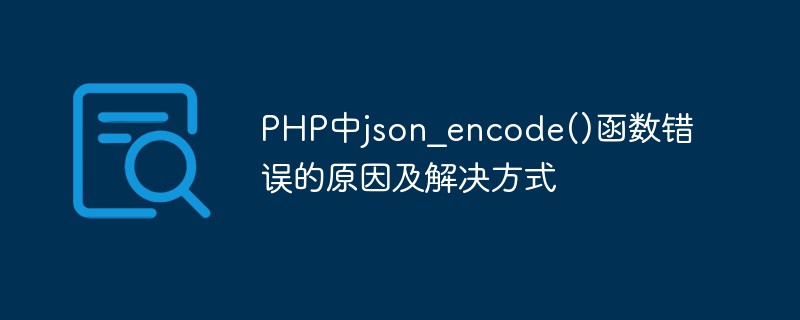 Backend Development
Backend Development PHP Tutorial
PHP Tutorial PHP error handling function implements program exception handling function
PHP error handling function implements program exception handling function
PHP error handling function implements the function of handling program exceptions
In the process of developing a program, various exceptions will inevitably occur, such as code errors , database connection failure, file reading error, etc. In order to better handle these exceptions, PHP provides a series of error handling functions to enable us to discover and handle problems in the program in a timely manner.
1. The role of the error handling function
The role of the error handling function is to capture and handle errors that occur in the program to prevent the program from exiting directly or displaying unfriendly error messages to the user. By using these error handling functions, we can take appropriate measures when an error occurs, such as logging error information, sending error reports, displaying a friendly user interface, etc.
2. Commonly used error handling functions
- error_reporting()
error_reporting() The function is used to set the current script to be able to The error level reported. This function accepts a parameter that specifies the error level to report.
Commonly used error levels include:
-
E_ALL: Report all errors and warnings -
E_ERROR: Report fatal Error -
E_WARNING: Reporting a non-fatal runtime warning -
E_NOTICE: Reporting a runtime notification
- set_error_handler()
set_error_handler() The function is used to customize the error handling function. When an error occurs, PHP calls a custom error handling function to handle the error.
The format of a custom error handling function is usually as follows:
function custom_error_handler($error_number, $error_message, $error_file, $error_line) {
// 处理错误的逻辑代码
} Among them, $error_number represents the level of the error, $error_message represents the specific error Content, $error_file represents the file name where the error is located, error_line represents the line number where the error is located.
- trigger_error()
trigger_error() The function is used to manually trigger an error message. It accepts a parameter that specifies the error message to trigger.
Commonly used triggers include:
-
E_USER_ERROR: Fatal user-generated error -
E_USER_WARNING: User Generated Warning -
E_USER_NOTICE: User Generated Tip
- error_log()
error_log( ) function is used to log error messages to the specified log file. It accepts three parameters, which are error message, log type and log file name.
Commonly used log types include:
-
0: Error messages are written to the server error log file -
1: The error message is sent to the PHP system log -
3: The error message is written to the specified file
3. Example of using the error handling function
The following is a simple example that demonstrates how to use error handling functions to catch and handle exceptions in your program.
// 设置报告的错误级别
error_reporting(E_ALL);
// 自定义错误处理函数
function custom_error_handler($error_number, $error_message, $error_file, $error_line) {
// 记录错误信息到日志文件
error_log("Error: [$error_number] $error_message in $error_file on line $error_line", 3, "error.log");
// 发送错误报告给管理员
mail("admin@example.com", "程序出错啦!", "错误信息:$error_message");
// 显示友好的错误界面
echo "抱歉,程序遇到了一些问题,请稍后再试!";
}
// 设置自定义的错误处理函数
set_error_handler("custom_error_handler");
// 触发一个致命错误
trigger_error("这是一个致命错误!", E_USER_ERROR);
// 触发一个警告
trigger_error("这是一个警告!", E_USER_WARNING);
// 触发一个提示
trigger_error("这是一个提示!", E_USER_NOTICE);In the above code, first use error_reporting() to set the reported error level to E_ALL, and then define a custom error handling functioncustom_error_handler(), this function will record the error information to the log file, send it to the administrator via email, and finally display a friendly error interface.
At the end of the code, we triggered a fatal error, a warning and a prompt through trigger_error() to verify whether our error handling function took effect.
Summary:
PHP’s error handling function provides us with a powerful tool for handling program exceptions and plays an important role in the development process. By properly using error handling functions, we can better capture and handle errors in the program and improve the stability and reliability of the program. Therefore, we should be proficient in the use of error handling functions and apply them to our projects to ensure the normal operation of the program.
The above is the detailed content of PHP error handling function implements program exception handling function. For more information, please follow other related articles on the PHP Chinese website!
 PHP语言开发中如何处理请求头错误?Jun 10, 2023 pm 05:24 PM
PHP语言开发中如何处理请求头错误?Jun 10, 2023 pm 05:24 PM在PHP语言开发中,请求头错误通常是由于HTTP请求中的一些问题导致的。这些问题可能包括无效的请求头、缺失的请求体以及无法识别的编码格式等。而正确处理这些请求头错误是保证应用程序稳定性和安全性的关键。在本文中,我们将讨论一些处理PHP请求头错误的最佳实践,帮助您构建更加可靠和安全的应用程序。检查请求方法HTTP协议规定了一组可用的请求方法(例如GET、POS
 PHP中json_encode()函数错误的原因及解决方式May 11, 2023 am 09:03 AM
PHP中json_encode()函数错误的原因及解决方式May 11, 2023 am 09:03 AM随着Web应用程序的不断发展,数据交互成为了一个非常重要的环节。其中,JSON(JavaScriptObjectNotation)是一种轻量级的数据交换格式,广泛用于前后端数据交互。在PHP中,json_encode()函数可以将PHP数组或对象转换为JSON格式字符串,json_decode()函数可以将JSON格式字符串转换为PHP数组或对象。然而,
 PHP命令行错误:你可能不知道的事情May 11, 2023 pm 08:21 PM
PHP命令行错误:你可能不知道的事情May 11, 2023 pm 08:21 PM本文将介绍关于PHP命令行错误的一些你可能不知道的事情。PHP作为一门流行的服务器端语言,一般运行在Web服务器上,但它也可以在命令行上直接运行,比如在Linux或者MacOS系统下,我们可以在终端中输入“php”命令来直接运行PHP脚本。不过,就像在Web服务器中一样,当我们在命令行中运行PHP脚本时,也会遇到一些错误。以下是一些你可能不知道的有关PHP命
 PHP语言开发中如何处理日期格式化错误?Jun 09, 2023 pm 06:40 PM
PHP语言开发中如何处理日期格式化错误?Jun 09, 2023 pm 06:40 PM在PHP语言开发中,日期格式化错误是一个常见的问题。正确的日期格式对于程序员来说十分重要,因为它决定着代码的可读性、可维护性和正确性。本文将分享一些处理日期格式化错误的技巧。了解日期格式在处理日期格式化错误之前,我们必须先了解日期格式。日期格式是由各种字母和符号组成的字符串,用于表示特定的日期和时间格式。在PHP中,常见的日期格式包括:Y:四位数年份(如20
 PHP中的容错机制May 23, 2023 am 08:16 AM
PHP中的容错机制May 23, 2023 am 08:16 AM在编写程序时总会存在各种各样的错误和异常。任何编程语言都需要有良好的容错机制,PHP也不例外。PHP有许多内置的错误和异常处理机制,可以让开发者更好地管理其代码,并正确地处理各种问题。下面就让我们一起来了解一下PHP中的容错机制。错误级别PHP中有四个错误级别:致命错误、严重错误、警告和通知。每个错误级别都有一个不同的符号表示,以帮助识别和处理错误:E_ER
 PHP语言开发中如何处理开发环境与生产环境的数据不一致错误?Jun 10, 2023 am 10:31 AM
PHP语言开发中如何处理开发环境与生产环境的数据不一致错误?Jun 10, 2023 am 10:31 AM随着互联网的快速发展,开发人员的任务也随之多样化和复杂化。特别是对于PHP语言开发人员而言,在开发过程中面临的最常见问题之一就是在开发环境和生产环境中,数据不一致的错误问题。因此,在开发PHP应用程序时,如何处理这些错误是开发人员必须面对的一个重要问题。开发环境和生产环境的区别首先需要明确的是,开发环境和生产环境是不同的,它们有着不同的设置和配置。在开发环境
 PHP语言开发中解析JSON时常见错误及处理方法Jun 10, 2023 pm 12:00 PM
PHP语言开发中解析JSON时常见错误及处理方法Jun 10, 2023 pm 12:00 PM在PHP语言开发中,常常需要解析JSON数据,以便进行后续的数据处理和操作。然而,在解析JSON时,很容易遇到各种错误和问题。本文将介绍常见的错误和处理方法,帮助PHP开发者更好地处理JSON数据。一、JSON格式错误最常见的错误是JSON格式不正确。JSON数据必须符合JSON规范,即数据必须是键值对的集合,并使用大括号({})和中括号([])来包含数据。
 国外程序员分享的PHP错误处理与调试技巧May 11, 2023 pm 12:12 PM
国外程序员分享的PHP错误处理与调试技巧May 11, 2023 pm 12:12 PMPHP(HypertextPreprocessor)是一种广泛用于Web开发的脚本语言。在开发PHP应用程序时,错误处理和调试被认为是非常重要的一块。国外程序员在经验中积累了许多PHP错误处理和调试技巧,下面介绍一些比较常见和实用的技巧。错误报告级别修改在PHP中,通过修改错误报告级别可以显示或禁止显示特定类型的PHP错误。通过设置错误报告级别为“E_AL


Hot AI Tools

Undresser.AI Undress
AI-powered app for creating realistic nude photos

AI Clothes Remover
Online AI tool for removing clothes from photos.

Undress AI Tool
Undress images for free

Clothoff.io
AI clothes remover

AI Hentai Generator
Generate AI Hentai for free.

Hot Article

Hot Tools

EditPlus Chinese cracked version
Small size, syntax highlighting, does not support code prompt function

SecLists
SecLists is the ultimate security tester's companion. It is a collection of various types of lists that are frequently used during security assessments, all in one place. SecLists helps make security testing more efficient and productive by conveniently providing all the lists a security tester might need. List types include usernames, passwords, URLs, fuzzing payloads, sensitive data patterns, web shells, and more. The tester can simply pull this repository onto a new test machine and he will have access to every type of list he needs.

Zend Studio 13.0.1
Powerful PHP integrated development environment

Atom editor mac version download
The most popular open source editor

SublimeText3 Chinese version
Chinese version, very easy to use




